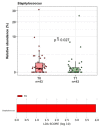Efficacy of Lactiplantibacillus plantarum PBS067, Bifidobacterium animalis subsp. lactis BL050, and Lacticaseibacillus rhamnosus LRH020 in the Amelioration of Vaginal Microbiota in Post-Menopausal Women: A Prospective Observational Clinical Trial
- PMID: 38337685
- PMCID: PMC10857347
- DOI: 10.3390/nu16030402
Efficacy of Lactiplantibacillus plantarum PBS067, Bifidobacterium animalis subsp. lactis BL050, and Lacticaseibacillus rhamnosus LRH020 in the Amelioration of Vaginal Microbiota in Post-Menopausal Women: A Prospective Observational Clinical Trial
Abstract
The menopausal transition marks a significant physiological shift in women. Menopause-related symptoms can significantly affect a woman's quality of life and probiotics have emerged as a promising avenue. This study aims to investigate the benefits of probiotics in improving vaginal well-being and microbiota composition in post-menopausal women. A prospective observational clinical trial was carried out enrolling 50 post-menopausal healthy women, aged between 45 and 65 years old, taking a supplement containing Lactiplantibacillus plantarum PBS067, Bifidobacterium animalis subsp. lactis BL050, and Lacticaseibacillus rhamnosus LRH020 (3B CFU/day) for 28 days. Vaginal swabs were collected to evaluate microbiota fluctuation and the inflammatory pattern was recorded. A Vaginal Health Index was provided to evaluate vaginal well-being throughout the trial. Clinical outcomes revealed a decrease in menopausal symptoms. Significant improvements were observed across various parameters: a 50% enhancement in the VHI score (p < 0.0001), alongside substantial reductions in inflammatory cytokine levels. An 87.8% decrease in IL-6, 57.6% in IL-1β, and 40.8% in TNF-α was observed (p < 0.05). Moreover, the probiotic intervention facilitated the restoration of vaginal microbiota, evidenced by an increase in lactobacilli abundance. In conclusion, the combination of these specific probiotic strains, previously clinically tested in childbearing-age women, showed to be effective also for post-menopausal women.
Keywords: genitourinary syndrome of menopause; immunity; lactobacilli; menopause; pro-inflammatory cytokines; probiotics; vaginal atrophy; vaginal microbiota.
Conflict of interest statement
Authors P.M. and D.F.S. were employed by the company Synbalance Srl. Authors E.V., A.M. and A.C. were employed by the company Wellmicro Srl. The remaining authors declare that the research was conducted in the absence of any commercial or financial relationships that could be construed as a potential conflict of interest.
Figures








Similar articles
-
Evaluation of Antimicrobial, Antiadhesive and Co-Aggregation Activity of a Multi-Strain Probiotic Composition against Different Urogenital Pathogens.Int J Mol Sci. 2023 Jan 10;24(2):1323. doi: 10.3390/ijms24021323. Int J Mol Sci. 2023. PMID: 36674840 Free PMC article.
-
Exploring the In Vitro Antibacterial Potential of Specific Probiotic Strains against Oral Pathogens.Microorganisms. 2024 Feb 21;12(3):441. doi: 10.3390/microorganisms12030441. Microorganisms. 2024. PMID: 38543492 Free PMC article.
-
Adjuvant Probiotics of Lactobacillus salivarius subsp. salicinius AP-32, L. johnsonii MH-68, and Bifidobacterium animalis subsp. lactis CP-9 Attenuate Glycemic Levels and Inflammatory Cytokines in Patients With Type 1 Diabetes Mellitus.Front Endocrinol (Lausanne). 2022 Mar 1;13:754401. doi: 10.3389/fendo.2022.754401. eCollection 2022. Front Endocrinol (Lausanne). 2022. PMID: 35299968 Free PMC article. Clinical Trial.
-
Health benefits of Lactobacillus rhamnosus GG and Bifidobacterium animalis subspecies lactis BB-12 in children.Postgrad Med. 2020 Jun;132(5):441-451. doi: 10.1080/00325481.2020.1731214. Epub 2020 Feb 26. Postgrad Med. 2020. PMID: 32059116 Review.
-
Evaluating the Efficacy of Probiotics in IBS Treatment Using a Systematic Review of Clinical Trials and Multi-Criteria Decision Analysis.Nutrients. 2022 Jun 28;14(13):2689. doi: 10.3390/nu14132689. Nutrients. 2022. PMID: 35807868 Free PMC article.
Cited by
-
Effective probiotic regimens for bacterial vaginosis treatment and recurrence prevention: A systematic review.Narra J. 2025 Apr;5(1):e1671. doi: 10.52225/narra.v5i1.1671. Epub 2025 Mar 10. Narra J. 2025. PMID: 40352249 Free PMC article.
-
Beyond hormones: 3PM approach to vaginal microbiota dynamics in postmenopausal women.EPMA J. 2025 Apr 15;16(2):299-350. doi: 10.1007/s13167-025-00406-7. eCollection 2025 Jun. EPMA J. 2025. PMID: 40438491 Review.
-
Influence of Lactobacillus rhamnosus Supplementation on the Glycaemic Index, Lipid Profile, and Microbiome of Healthy Elderly Subjects: A Preliminary Randomized Clinical Trial.Foods. 2024 Apr 23;13(9):1293. doi: 10.3390/foods13091293. Foods. 2024. PMID: 38731665 Free PMC article.
-
Probiotic Lactobacillus rhamnosus species: considerations for female reproduction and offspring health.J Assist Reprod Genet. 2024 Oct;41(10):2585-2605. doi: 10.1007/s10815-024-03230-6. Epub 2024 Aug 22. J Assist Reprod Genet. 2024. PMID: 39172320 Review.
-
Expert Opinion on the Use of Probiotics in General Gynecological Conditions.Cureus. 2025 Mar 20;17(3):e80875. doi: 10.7759/cureus.80875. eCollection 2025 Mar. Cureus. 2025. PMID: 40255841 Free PMC article. Review.
References
-
- Comparetto C., Borruto F. Treatments and Management of Menopausal Symptoms: Current Status and Future Challenges. OBM Geriatr. 2023;7:1–47. doi: 10.21926/obm.geriatr.2303248. - DOI
-
- Harlow S.D., Gass M., Hall J.E., Lobo R., Maki P., Rebar R.W., Sherman S., Sluss P.M., De Villiers T.J. Executive Summary of the Stages of Reproductive Aging Workshop + 10: Addressing the Unfinished Agenda of Staging Reproductive Aging. Menopause. 2012;19:387–395. doi: 10.1097/gme.0b013e31824d8f40. - DOI - PMC - PubMed
-
- Rindner L., Nordeman L., Strömme G., Hange D., Gunnarsson R., Rembeck G. Effect of Group Education and Person-Centered Support in Primary Health Care on Mental Health and Quality of Life in Women Aged 45–60 Years with Symptoms Commonly Associated with Stress: A Randomized Controlled Trial. BMC Womens Health. 2023;23:128. doi: 10.1186/s12905-023-02221-6. - DOI - PMC - PubMed
Publication types
MeSH terms
LinkOut - more resources
Full Text Sources

